Abstract
Heparan sulphate (HS) was isolated after proteolytic digestion of cerebral cortex, obtained at autopsy, of patients with Alzheimer's disease (AD) and of control subjects. Deaminative cleavage in combination with selective radiolabelling procedures showed that the N-acetylated regions in the intact polysaccharides ranged from isolated residues to approximately 10 consecutive N-acetylated disaccharide units, without any apparent difference between AD and control HS. The yield of disaccharide deamination products was slightly higher with AD than with control HS, suggesting a differential distribution of N-sulphate groups. Separation of the disaccharides by anion-exchange h.p.l.c. yielded four mono-O-sulphated and one di-O-sulphated disaccharide; these components occurred in strikingly similar proportions in all cerebral HS preparations (except polysaccharide from neonatal brain) irrespective of the age of the individual and the histopathology of the cortex specimen. No significant difference was noted between HS obtained from control and from AD tissue. By contrast, the composition of HS isolated from brain differed significantly from that of HS preparations derived from other human organs.
Full text
PDF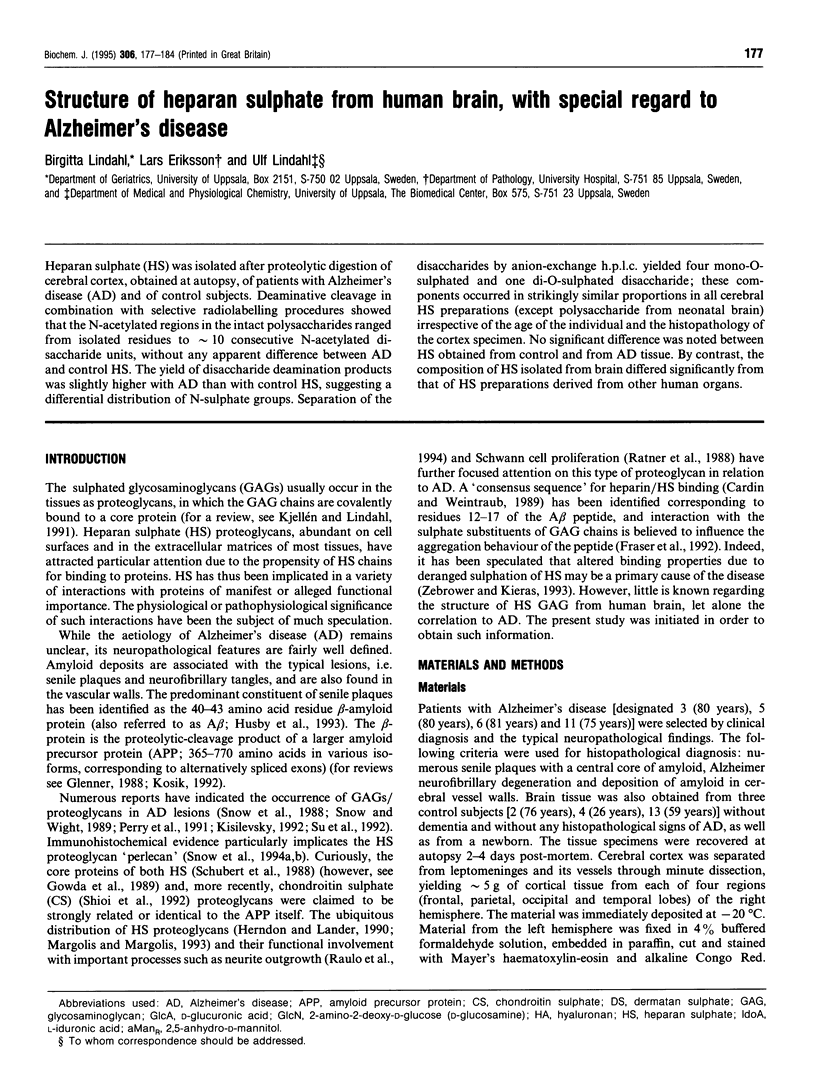

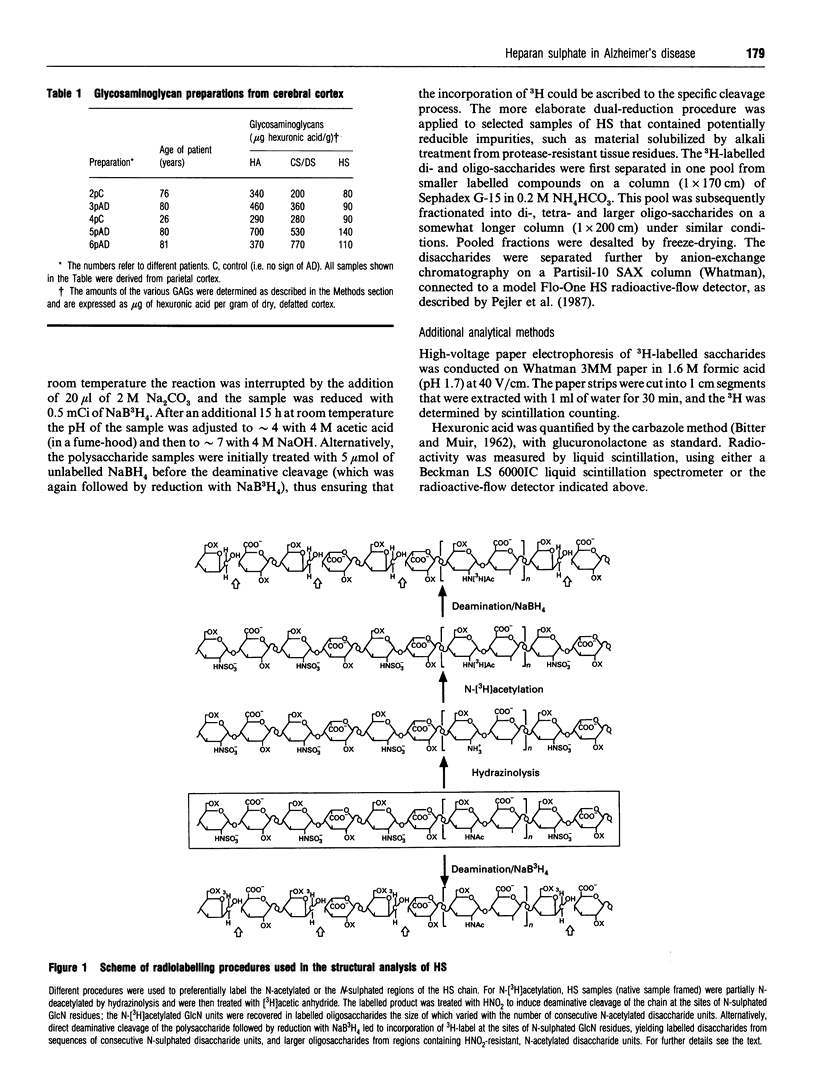

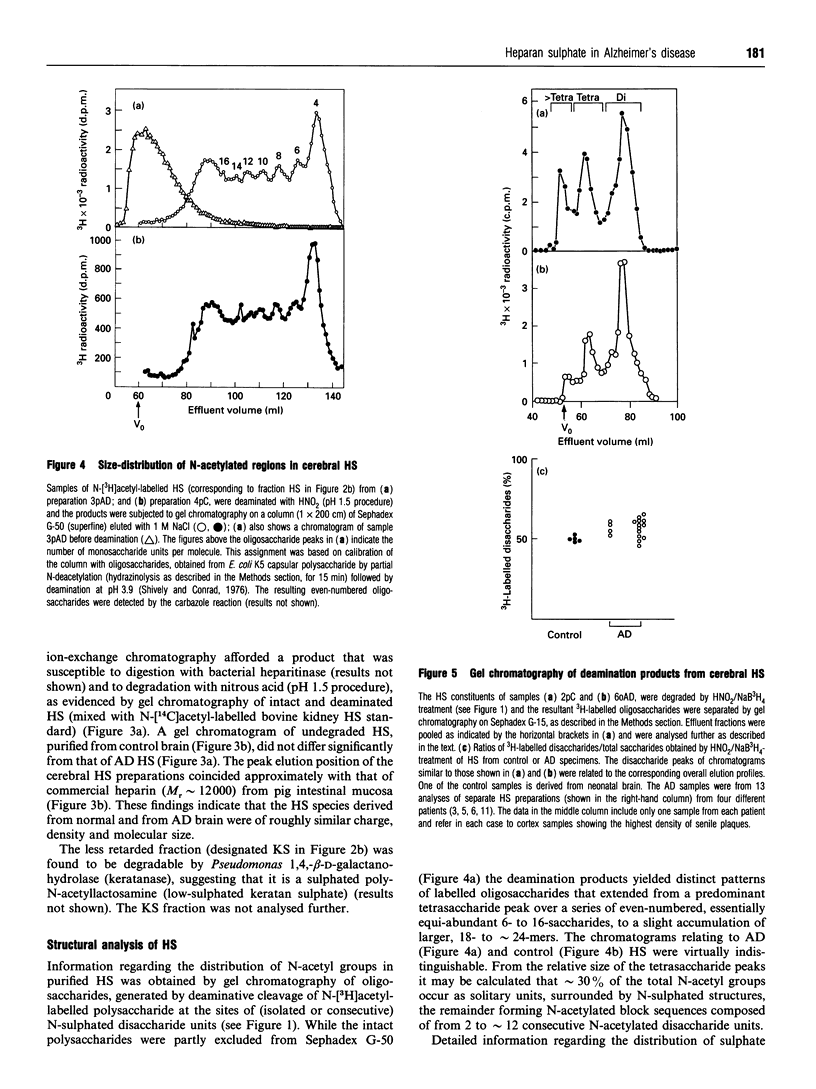

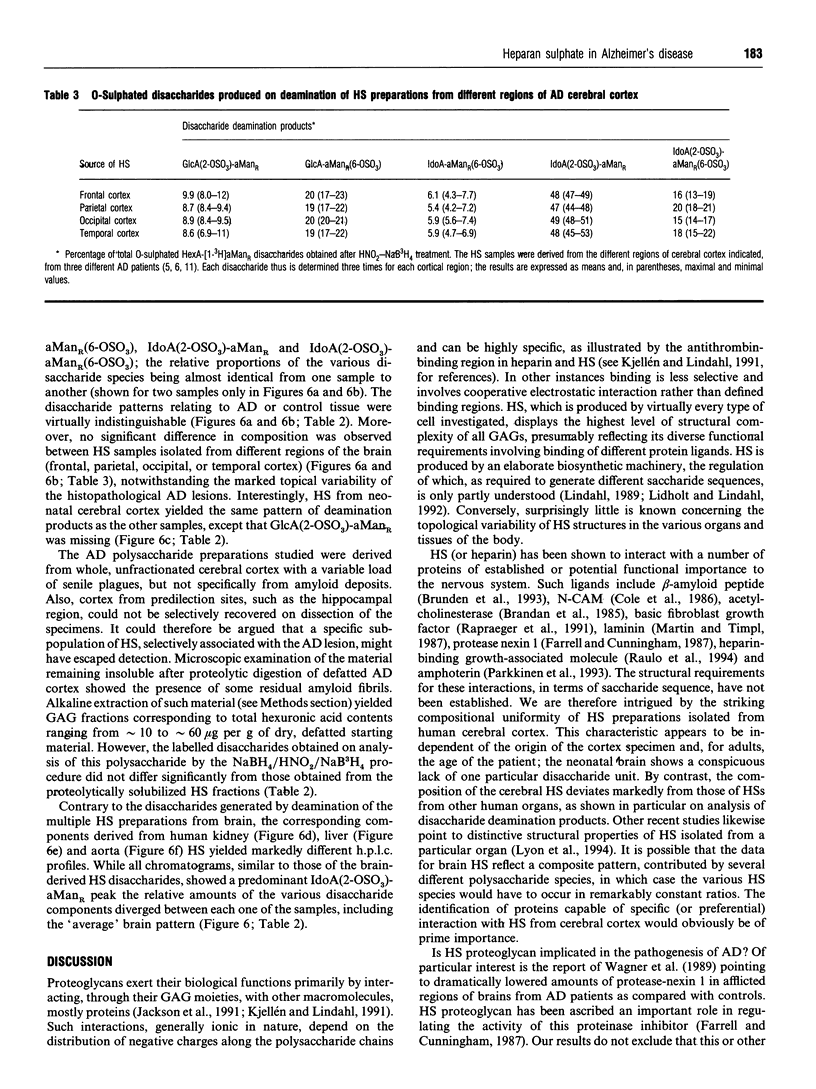
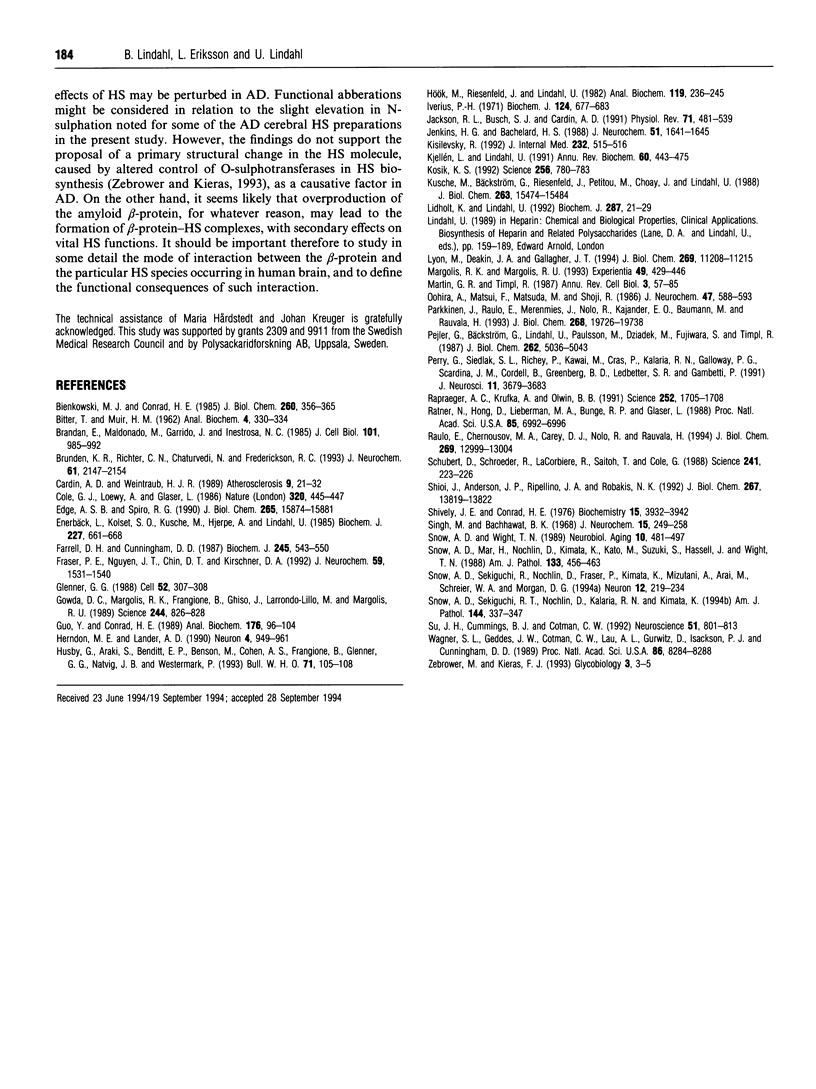
Selected References
These references are in PubMed. This may not be the complete list of references from this article.
- BITTER T., MUIR H. M. A modified uronic acid carbazole reaction. Anal Biochem. 1962 Oct;4:330–334. doi: 10.1016/0003-2697(62)90095-7. [DOI] [PubMed] [Google Scholar]
- Bienkowski M. J., Conrad H. E. Structural characterization of the oligosaccharides formed by depolymerization of heparin with nitrous acid. J Biol Chem. 1985 Jan 10;260(1):356–365. [PubMed] [Google Scholar]
- Brandan E., Maldonado M., Garrido J., Inestrosa N. C. Anchorage of collagen-tailed acetylcholinesterase to the extracellular matrix is mediated by heparan sulfate proteoglycans. J Cell Biol. 1985 Sep;101(3):985–992. doi: 10.1083/jcb.101.3.985. [DOI] [PMC free article] [PubMed] [Google Scholar]
- Brunden K. R., Richter-Cook N. J., Chaturvedi N., Frederickson R. C. pH-dependent binding of synthetic beta-amyloid peptides to glycosaminoglycans. J Neurochem. 1993 Dec;61(6):2147–2154. doi: 10.1111/j.1471-4159.1993.tb07453.x. [DOI] [PubMed] [Google Scholar]
- Cardin A. D., Weintraub H. J. Molecular modeling of protein-glycosaminoglycan interactions. Arteriosclerosis. 1989 Jan-Feb;9(1):21–32. doi: 10.1161/01.atv.9.1.21. [DOI] [PubMed] [Google Scholar]
- Cole G. J., Loewy A., Glaser L. Neuronal cell-cell adhesion depends on interactions of N-CAM with heparin-like molecules. Nature. 1986 Apr 3;320(6061):445–447. doi: 10.1038/320445a0. [DOI] [PubMed] [Google Scholar]
- Edge A. S., Spiro R. G. Characterization of novel sequences containing 3-O-sulfated glucosamine in glomerular basement membrane heparan sulfate and localization of sulfated disaccharides to a peripheral domain. J Biol Chem. 1990 Sep 15;265(26):15874–15881. [PubMed] [Google Scholar]
- Enerbäck L., Kolset S. O., Kusche M., Hjerpe A., Lindahl U. Glycosaminoglycans in rat mucosal mast cells. Biochem J. 1985 Apr 15;227(2):661–668. doi: 10.1042/bj2270661. [DOI] [PMC free article] [PubMed] [Google Scholar]
- Farrell D. H., Cunningham D. D. Glycosaminoglycans on fibroblasts accelerate thrombin inhibition by protease nexin-1. Biochem J. 1987 Jul 15;245(2):543–550. doi: 10.1042/bj2450543. [DOI] [PMC free article] [PubMed] [Google Scholar]
- Fraser P. E., Nguyen J. T., Chin D. T., Kirschner D. A. Effects of sulfate ions on Alzheimer beta/A4 peptide assemblies: implications for amyloid fibril-proteoglycan interactions. J Neurochem. 1992 Oct;59(4):1531–1540. doi: 10.1111/j.1471-4159.1992.tb08470.x. [DOI] [PubMed] [Google Scholar]
- Glenner G. G. Alzheimer's disease: its proteins and genes. Cell. 1988 Feb 12;52(3):307–308. doi: 10.1016/s0092-8674(88)80021-7. [DOI] [PubMed] [Google Scholar]
- Gowda D. C., Margolis R. K., Frangione B., Ghiso J., Larrondo-Lillo M., Margolis R. U. Relation of the amyloid beta protein precursor to heparan sulfate proteoglycans. Science. 1989 May 19;244(4906):826–828. doi: 10.1126/science.2499044. [DOI] [PubMed] [Google Scholar]
- Guo Y. C., Conrad H. E. The disaccharide composition of heparins and heparan sulfates. Anal Biochem. 1989 Jan;176(1):96–104. doi: 10.1016/0003-2697(89)90278-9. [DOI] [PubMed] [Google Scholar]
- Herndon M. E., Lander A. D. A diverse set of developmentally regulated proteoglycans is expressed in the rat central nervous system. Neuron. 1990 Jun;4(6):949–961. doi: 10.1016/0896-6273(90)90148-9. [DOI] [PubMed] [Google Scholar]
- Hök M., Riesenfeld J., Lindahl U. N-[3H]Acetyl-labeling, a convenient method for radiolabeling of glycosaminoglycans. Anal Biochem. 1982 Jan 15;119(2):236–245. doi: 10.1016/0003-2697(82)90580-2. [DOI] [PubMed] [Google Scholar]
- Iverius P. H. Coupling of glycosaminoglycans to agarose beads (sepharose 4B). Biochem J. 1971 Oct;124(4):677–683. doi: 10.1042/bj1240677. [DOI] [PMC free article] [PubMed] [Google Scholar]
- Jackson R. L., Busch S. J., Cardin A. D. Glycosaminoglycans: molecular properties, protein interactions, and role in physiological processes. Physiol Rev. 1991 Apr;71(2):481–539. doi: 10.1152/physrev.1991.71.2.481. [DOI] [PubMed] [Google Scholar]
- Jenkins H. G., Bachelard H. S. Glycosaminoglycans in cortical autopsy samples from Alzheimer brain. J Neurochem. 1988 Nov;51(5):1641–1645. doi: 10.1111/j.1471-4159.1988.tb01135.x. [DOI] [PubMed] [Google Scholar]
- Kisilevsky R. Proteoglycans, glycosaminoglycans, amyloid-enhancing factor, and amyloid deposition. J Intern Med. 1992 Dec;232(6):515–516. doi: 10.1111/j.1365-2796.1992.tb00628.x. [DOI] [PubMed] [Google Scholar]
- Kjellén L., Lindahl U. Proteoglycans: structures and interactions. Annu Rev Biochem. 1991;60:443–475. doi: 10.1146/annurev.bi.60.070191.002303. [DOI] [PubMed] [Google Scholar]
- Kosik K. S. Alzheimer's disease: a cell biological perspective. Science. 1992 May 8;256(5058):780–783. doi: 10.1126/science.1589757. [DOI] [PubMed] [Google Scholar]
- Kusche M., Bäckström G., Riesenfeld J., Petitou M., Choay J., Lindahl U. Biosynthesis of heparin. O-sulfation of the antithrombin-binding region. J Biol Chem. 1988 Oct 25;263(30):15474–15484. [PubMed] [Google Scholar]
- Lidholt K., Lindahl U. Biosynthesis of heparin. The D-glucuronosyl- and N-acetyl-D-glucosaminyltransferase reactions and their relation to polymer modification. Biochem J. 1992 Oct 1;287(Pt 1):21–29. doi: 10.1042/bj2870021. [DOI] [PMC free article] [PubMed] [Google Scholar]
- Lyon M., Deakin J. A., Gallagher J. T. Liver heparan sulfate structure. A novel molecular design. J Biol Chem. 1994 Apr 15;269(15):11208–11215. [PubMed] [Google Scholar]
- Margolis R. K., Margolis R. U. Nervous tissue proteoglycans. Experientia. 1993 May 15;49(5):429–446. doi: 10.1007/BF01923587. [DOI] [PubMed] [Google Scholar]
- Martin G. R., Timpl R. Laminin and other basement membrane components. Annu Rev Cell Biol. 1987;3:57–85. doi: 10.1146/annurev.cb.03.110187.000421. [DOI] [PubMed] [Google Scholar]
- Oohira A., Matsui F., Matsuda M., Shoji R. Developmental change in the glycosaminoglycan composition of the rat brain. J Neurochem. 1986 Aug;47(2):588–593. doi: 10.1111/j.1471-4159.1986.tb04540.x. [DOI] [PubMed] [Google Scholar]
- Parkkinen J., Raulo E., Merenmies J., Nolo R., Kajander E. O., Baumann M., Rauvala H. Amphoterin, the 30-kDa protein in a family of HMG1-type polypeptides. Enhanced expression in transformed cells, leading edge localization, and interactions with plasminogen activation. J Biol Chem. 1993 Sep 15;268(26):19726–19738. [PubMed] [Google Scholar]
- Pejler G., Bäckström G., Lindahl U., Paulsson M., Dziadek M., Fujiwara S., Timpl R. Structure and affinity for antithrombin of heparan sulfate chains derived from basement membrane proteoglycans. J Biol Chem. 1987 Apr 15;262(11):5036–5043. [PubMed] [Google Scholar]
- Perry G., Siedlak S. L., Richey P., Kawai M., Cras P., Kalaria R. N., Galloway P. G., Scardina J. M., Cordell B., Greenberg B. D. Association of heparan sulfate proteoglycan with the neurofibrillary tangles of Alzheimer's disease. J Neurosci. 1991 Nov;11(11):3679–3683. doi: 10.1523/JNEUROSCI.11-11-03679.1991. [DOI] [PMC free article] [PubMed] [Google Scholar]
- Rapraeger A. C., Krufka A., Olwin B. B. Requirement of heparan sulfate for bFGF-mediated fibroblast growth and myoblast differentiation. Science. 1991 Jun 21;252(5013):1705–1708. doi: 10.1126/science.1646484. [DOI] [PubMed] [Google Scholar]
- Ratner N., Hong D. M., Lieberman M. A., Bunge R. P., Glaser L. The neuronal cell-surface molecule mitogenic for Schwann cells is a heparin-binding protein. Proc Natl Acad Sci U S A. 1988 Sep;85(18):6992–6996. doi: 10.1073/pnas.85.18.6992. [DOI] [PMC free article] [PubMed] [Google Scholar]
- Raulo E., Chernousov M. A., Carey D. J., Nolo R., Rauvala H. Isolation of a neuronal cell surface receptor of heparin binding growth-associated molecule (HB-GAM). Identification as N-syndecan (syndecan-3). J Biol Chem. 1994 Apr 29;269(17):12999–13004. [PubMed] [Google Scholar]
- Schubert D., Schroeder R., LaCorbiere M., Saitoh T., Cole G. Amyloid beta protein precursor is possibly a heparan sulfate proteoglycan core protein. Science. 1988 Jul 8;241(4862):223–226. doi: 10.1126/science.2968652. [DOI] [PubMed] [Google Scholar]
- Shively J. E., Conrad H. E. Formation of anhydrosugars in the chemical depolymerization of heparin. Biochemistry. 1976 Sep 7;15(18):3932–3942. doi: 10.1021/bi00663a005. [DOI] [PubMed] [Google Scholar]
- Singh M., Bachhawat B. K. Isolation and characterization of glycosaminoglycans in human brain of different age groups. J Neurochem. 1968 Mar;15(3):249–258. doi: 10.1111/j.1471-4159.1968.tb06204.x. [DOI] [PubMed] [Google Scholar]
- Snow A. D., Mar H., Nochlin D., Kimata K., Kato M., Suzuki S., Hassell J., Wight T. N. The presence of heparan sulfate proteoglycans in the neuritic plaques and congophilic angiopathy in Alzheimer's disease. Am J Pathol. 1988 Dec;133(3):456–463. [PMC free article] [PubMed] [Google Scholar]
- Snow A. D., Sekiguchi R. T., Nochlin D., Kalaria R. N., Kimata K. Heparan sulfate proteoglycan in diffuse plaques of hippocampus but not of cerebellum in Alzheimer's disease brain. Am J Pathol. 1994 Feb;144(2):337–347. [PMC free article] [PubMed] [Google Scholar]
- Snow A. D., Sekiguchi R., Nochlin D., Fraser P., Kimata K., Mizutani A., Arai M., Schreier W. A., Morgan D. G. An important role of heparan sulfate proteoglycan (Perlecan) in a model system for the deposition and persistence of fibrillar A beta-amyloid in rat brain. Neuron. 1994 Jan;12(1):219–234. doi: 10.1016/0896-6273(94)90165-1. [DOI] [PubMed] [Google Scholar]
- Snow A. D., Wight T. N. Proteoglycans in the pathogenesis of Alzheimer's disease and other amyloidoses. Neurobiol Aging. 1989 Sep-Oct;10(5):481–497. doi: 10.1016/0197-4580(89)90108-5. [DOI] [PubMed] [Google Scholar]
- Su J. H., Cummings B. J., Cotman C. W. Localization of heparan sulfate glycosaminoglycan and proteoglycan core protein in aged brain and Alzheimer's disease. Neuroscience. 1992 Dec;51(4):801–813. doi: 10.1016/0306-4522(92)90521-3. [DOI] [PubMed] [Google Scholar]
- Wagner S. L., Geddes J. W., Cotman C. W., Lau A. L., Gurwitz D., Isackson P. J., Cunningham D. D. Protease nexin-1, an antithrombin with neurite outgrowth activity, is reduced in Alzheimer disease. Proc Natl Acad Sci U S A. 1989 Nov;86(21):8284–8288. doi: 10.1073/pnas.86.21.8284. [DOI] [PMC free article] [PubMed] [Google Scholar]
- Zebrower M., Kieras F. J. Are heparan sulphate (HS) sulphotransferases implicated in the pathogenesis of Alzheimer's disease? Glycobiology. 1993 Feb;3(1):3–5. doi: 10.1093/glycob/3.1.3. [DOI] [PubMed] [Google Scholar]


